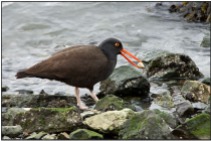Who, when he had found one pearl of great price, went and sold all that he had, and bought it. (Matthew 13:46 KJV)
CLASS – AVES, Order – CHARADRIIFORMES, Family – Haematopodidae – Oystercatchers
Latest I.O.C. Version
Species (12)
*
Magellanic Oystercatcher (Haematopus leucopodus)
Blackish Oystercatcher (Haematopus ater)
Black Oystercatcher (Haematopus bachmani)
American Oystercatcher (Haematopus palliatus)
Canary Islands Oystercatcher (Haematopus meadewaldoi)
African Oystercatcher (Haematopus moquini)
Eurasian Oystercatcher (Haematopus ostralegus)
South Island Oystercatcher (Haematopus finschi)
Pied Oystercatcher (Haematopus longirostris)
Variable Oystercatcher (Haematopus unicolor)
Chatham Oystercatcher (Haematopus chathamensis)
Sooty Oystercatcher (Haematopus fuliginosus)
On the photos or slides, a “by” indicates one of the photographers or videographers, who have given their permission, with links on our sidebar. Please visit their site to see many more fantastic shots, a “©©” copyright symbol indicates a photo from Creative Commons and ©WikiC is a Creative Commons photo from Wikipedia.
Photographers or Videographers used on this page from our sidebar, Photography, are:
Dave’s BirdingPix
Ian Montgomery’s Birdway
Nikhil Devasar’s Gallery
Robert Scanlon’s Gallery
Tom Tarrant
William Kwong’s Galleries
Back to Family Page – CLICK HERE
*
Articles Mentioning Birds From This Family:
- None so far, stay tuned!
Other Websites that have photos of this Family:
- Haematopodidae – OBI
- Haematopodidae – IBC
- Haematopodidae – Wikipedia
- Haematopodidae – Le quide ornitho
*
“The oystercatchers are a group of waders; they form the family Haematopodidae, which has a single genus, Haematopus. They are found on coasts worldwide apart from the polar regions and some tropical regions of Africa and South East Asia. The exception to this is the Eurasian Oystercatcher and the South Island Oystercatcher, both of which breed inland, far inland in some cases. In the past there has been a great deal of confusion as to the species limits, with discrete populations of all black oystercatchers being afforded specific status but pied oystercatchers being considered one single species.”
The different species of oystercatcher show little variation in shape or appearance. They range from 39–50 cm (15–20 in) in length and 72–91 cm (28–36 in) in wingspan. The Eurasian Oystercatcher is the lightest on average, at 526 g (1.16 lb), while the Sooty Oystercatcher is the heaviest, at 833 g (1.84 lb). The plumage of all species is either all-black, or black (or dark brown) on top and white underneath. The Variable Oystercatcher is slightly exceptional in being either all-black or pied. They are large, obvious, and noisy plover-like birds, with massive long orange or red bills used for smashing or prying open molluscs. The bill shape varies between species, according to the diet. Those birds with blade-like bill tips pry open or smash mollusc shells, and those with pointed bill tips tend to probe for annelid worms. They show sexual dimorphism, with females being longer-billed and heavier than males.” (Wikipedia with editing)
Some of the Family – Photos are Alphabetical down the columns:














Pingback: Bird Watching » Blog Archive » Ian's Bird of the Week – Sooty Oystercatcher « Lee's Birdwatching …